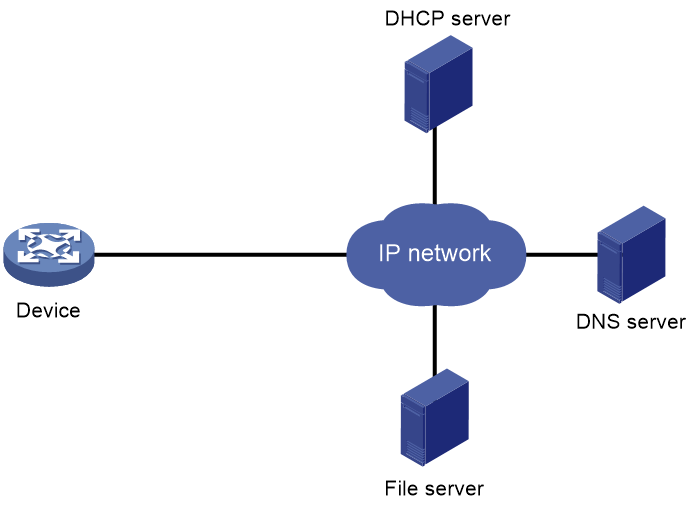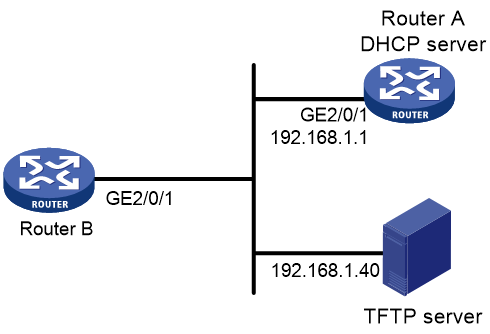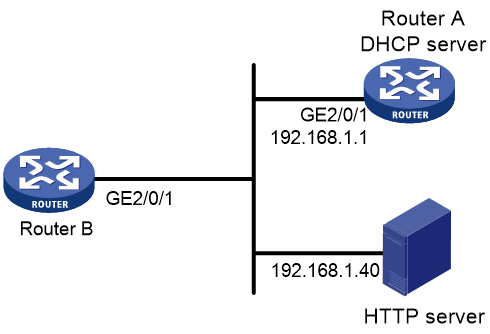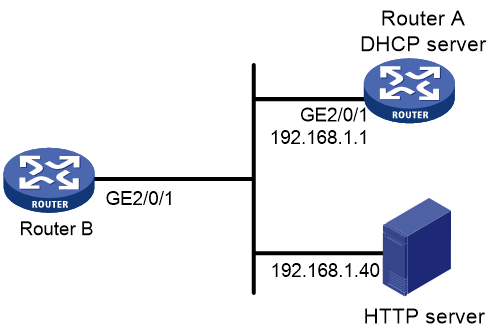- Table of Contents
-
- 01-Fundamentals Configuration Guide
- 00-Preface
- 01-CLI configuration
- 02-FTP and TFTP configuration
- 03-Target configuration management configuration
- 04-RBAC configuration
- 05-File system management configuration
- 06-Login management configuration
- 07-Automatic configuration
- 08-Software upgrade configuration
- 09-Configuration file management configuration
- 10-ISSU configuration
- Related Documents
-
| Title | Size | Download |
|---|---|---|
| 07-Automatic configuration | 196.11 KB |
Contents
Using server-based automatic configuration
About server-based automatic configuration
Server-based automatic configuration tasks at a glance
Preparing the interface used for automatic configuration
Starting and completing automatic configuration
Using USB-based automatic configuration
About USB-based automatic configuration
Preparing the USB disk for automatic configuration
Configuring and using USB-based automatic configuration
Server-based automatic configuration examples
Example: Using a TFTP server for automatic configuration
Example: Using an HTTP server and Tcl scripts for automatic configuration
Example: Using an HTTP server and Python scripts for automatic configuration
Using automatic configuration
About automatic configuration
When the device starts up without a valid next-startup configuration file, the device searches the root directory of its default file system for the autocfg.py, autocfg.tcl, and autocfg.cfg files. Only one of files might exist in the root directory. If any one of the files exists, the device loads the file. If none of the files exists, the device uses the automatic configuration feature to obtain a set of configuration settings.
With the automatic configuration feature, the device can automatically obtain a set of configuration settings at startup. This feature simplifies network configuration and maintenance.
Automatic configuration can be implemented by using the implementation methods in Table 1.
Table 1 Automatic configuration implementation methods
|
Implementation method |
Configuration file location |
Application scenarios |
|
Server-based automatic configuration |
File server |
A number of geographically distributed devices need to be configured. |
|
URL-based automatic configuration |
Saved on the device before the device is shipped |
Devices are geographically distributed. |
|
USB-based automatic configuration |
USB disk |
· On a small network, the devices reside near to each other, and no host can be used as a file server. · On a large network, only a few devices require automatic configuration or configuration update. |
If both server-based automatic configuration and USB-based automatic configuration are available, the device prefers USB-based automatic configuration.
Using server-based automatic configuration
About server-based automatic configuration
As shown in Figure 1, server-based automatic configuration requires the following servers:
· DHCP server.
· File server (TFTP or HTTP server).
· (Optional.) DNS server.
Figure 1 Server-based automatic configuration network diagram
Server-based automatic configuration tasks at a glance
To configure server-based automatic configuration, perform the following tasks:
1. Configuring the file server
2. Prepare the files for automatic configuration:
¡ Preparing configuration files
3. Configuring the DHCP server
4. (Optional.) Configuring the DNS server
5. (Optional.) Configuring the gateway
6. Preparing the interface used for automatic configuration
7. Starting and completing automatic configuration
Configuring the file server
For devices to obtain configuration information from a TFTP server, start TFTP service on the file server.
For devices to obtain configuration information from an HTTP server, start HTTP service on the file server.
Preparing configuration files
Configuration file types
The device supports the configuration file types listed in Table 2.
Table 2 Configuration file types
|
Configuration file type |
Application objects |
File name requirements |
Supported file server types |
|
Dedicated configuration file |
Devices that require different settings |
File name.cfg For simple file name identification, use configuration file names that do not contain spaces. |
· TFTP server · HTTP server |
|
Common configuration file |
Devices that share all or some settings |
File name.cfg |
· TFTP server · HTTP server |
|
Default configuration file |
Other devices. The file contains only common configurations that devices use to start up. |
device.cfg |
TFTP server |
Identifying requirements for and preparing configuration files
1. Identify the requirements of the devices for configuration files.
2. For devices that require different configurations, prepare a configuration file for each of them and save the files to the file server.
3. For devices that share all or some configurations, save the common configurations to a .cfg file on the file server.
4. If a TFTP file server is used, you can save the common configurations that devices use to start up to the device.cfg file on the server. The file is assigned to a device only when the device does not have any other configuration file to use.
Preparing the host name file on the TFTP server
If a TFTP server is used and the DHCP server does not assign configuration file names, you can configure a host name file on the TFTP server. The host name file contains the host name-IP address mappings of the devices to be automatically configured.
To prepare the host name file:
1. Create a host name file named network.cfg.
2. Add each mapping entry in the ip host host-name ip-address format on a separate line. For example:
ip host host1 101.101.101.101
ip host host2 101.101.101.102
ip host client1 101.101.101.103
ip host client2 101.101.101.104
|
IMPORTANT: The host name for a device must be the same as the name of the configuration file configured for the device. |
Preparing script files
About this task
Script files can be used for automatic software upgrade and automatic configuration.
The device supports Python scripts (.py files) and Tcl scripts (.tcl files). For more information about Python and Tcl scripts, see "Using Python" and "Using Tcl."
The device supports dedicated script files and common dedicated script files. It does not support using a default script file. For information about dedicated script files and common dedicated script files, see Table 2.
When script files are used, you cannot use a host name file to provide the host name-IP address mappings for devices.
Restrictions and guidelines
To use a Tcl script, make sure all commands in the script are supported and correctly configured. Any error in a command causes the automatic configuration process to quit.
Procedure
· For devices that share all or some configurations, create a script file that contains the common configurations.
· For the other devices, create a separate script file for each of them.
Configuring the DHCP server
About this task
The DHCP server assigns the following items to devices that need to be automatically configured:
· IP addresses.
· Paths of the configuration or script files.
Restrictions and guidelines
When you configure the DHCP server, follow these guidelines:
· For devices for which you have prepared different configuration files, perform the following tasks for each of the devices on the DHCP server:
¡ Create a DHCP address pool.
¡ Configure a static address binding.
¡ Specify a configuration file or script file.
Because an address pool can use only one configuration file, you can specify only one static address binding for an address pool.
· For devices for which you have prepared the same configuration file, use either of the following methods:
¡ Method 1:
- Create a DHCP address pool for the devices.
- Configure a static address binding for each of the devices in the address pool.
- Specify the configuration file for the devices.
¡ Method 2:
- Create a DHCP address pool for the devices.
- Specify the subnet for dynamic allocation.
- Specify the TFTP server.
- Specify the configuration file for the devices.
· If all devices on a subnet share the same configuration file or script file, perform the following tasks on the DHCP server:
¡ Configure dynamic address allocation.
¡ Specify the configuration file or script file for the devices.
The configuration file can contain only the common settings for the devices. You can provide a method for the device administrators to change the configurations after their devices start up.
Configuring the DHCP server when an HTTP file server is used
1. Enter system view.
system-view
2. Enable DHCP.
dhcp enable
By default, DHCP is disabled.
3. Create a DHCP address pool and enter its view.
dhcp server ip-pool pool-name
4. Configure the address pool.
Choose the options to configure as needed:
¡ Specify the primary subnet for the address pool.
network network-address [ mask-length | mask mask ]
By default, no primary subnet is specified.
¡ Configure a static binding.
static-bind ip-address ip-address [ mask-length | mask mask ] { client-identifier client-identifier | hardware-address hardware-address [ ethernet | token-ring ] }
By default, no static binding is configured.
You can configure multiple static bindings. However, one IP address can be bound to only one client. To change the binding for a DHCP client, you must remove the binding and reconfigure a binding.
5. Specify the URL of the configuration or script file.
bootfile-name url
By default, no configuration or script file URL is specified.
Configuring the DHCP server when a TFTP file server is used
1. Enter system view.
system-view
2. Enable DHCP.
dhcp enable
By default, DHCP is disabled.
3. Create a DHCP address pool and enter its view.
dhcp server ip-pool pool-name
4. Configure the address pool.
Choose the options to configure as needed:
¡ Specify the primary subnet for the address pool.
network network-address [ mask-length | mask mask ]
By default, no primary subnet is specified.
¡ Configure a static binding.
static-bind ip-address ip-address [ mask-length | mask mask ] { client-identifier client-identifier | hardware-address hardware-address [ ethernet | token-ring ] }
By default, no static binding is configured.
You can configure multiple static bindings. However, one IP address can be bound to only one client. To change the binding for a DHCP client, you must remove the binding and reconfigure a binding.
5. Specify a TFTP server.
Choose one option as needed:
¡ Specify the IP address of the TFTP server.
tftp-server ip-address ip-address
By default, no TFTP server IP address is specified.
¡ Specify the name of the TFTP server.
tftp-server domain-name domain-name
By default, no TFTP server name is specified.
If you specify a TFTP server by its name, a DNS server is required on the network.
6. Specify the name of the configuration or script file.
bootfile-name bootfile-name
By default, no configuration or script file name is specified.
Configuring the DNS server
A DNS server is required in the following situations:
· The TFTP server does not have a host name file.
Devices need to provide the DNS server with their IP addresses to obtain their host names. Then, the devices can obtain configuration files named in the host name.cfg format from the TFTP server.
· The DHCP server assigns the TFTP server domain name through the DHCP reply message. Devices must use the domain name to obtain the IP address of the TFTP server.
Configuring the gateway
If the devices to be automatically configured and the servers for automatic configuration reside in different network segments, you must perform the following tasks:
· Deploy a gateway and make sure the devices can communicate with the servers.
· Configure the DHCP relay agent feature on the gateway.
· Configure the UDP helper feature on the gateway.
This task is required if devices send requests to a TFTP server by using broadcast packets. A device uses broadcast packets to send requests to a TFTP server in the following situations:
¡ The DHCP reply does not contain the IP address or domain name of the TFTP server.
¡ The IP address or domain name of the TFTP server is invalid.
The UDP helper transforms a broadcast packet into a unicast packet and forwards the unicast packet to the file server. For more information about UDP helper, see Layer 3—IP Services Configuration Guide.
Preparing the interface used for automatic configuration
The device uses the following steps to select the interface for automatic configuration:
1. Identifies the status of the management Ethernet interface at Layer 2. If the status is up, the device uses the management Ethernet interface.
2. If no Layer 3 Ethernet interfaces are in up state, the device waits 30 seconds and goes to step 1 to try again.
For fast automatic device configuration, connect only the management Ethernet interface on each device to the network.
Starting and completing automatic configuration
1. Power on the devices to be automatically configured.
If a device does not find a next-start configuration file locally, it starts the automatic configuration process to obtain a configuration file.
¡ If the device obtains a configuration file and executes the file successfully, the automatic configuration process ends.
¡ If one attempt fails, the device tries again until the maximum number of attempts is reached. To stop the process, press Ctrl+C or Ctrl+D as prompted.
If the device fails to obtain a configuration file, the device starts up without loading any configuration.
2. Save the running configuration.
save
The device does not save the obtained configuration file locally. If you do not save the running configuration, the device must use the automatic configuration feature again after a reboot.
For more information about the save command, see configuration file management in Fundamentals Command Reference.
Using USB-based automatic configuration
About USB-based automatic configuration
USB-based automatic configuration enables the device to obtain a configuration file from a connected USB disk at startup.
The configuration file can be in either of the following forms:
· Plaintext form—The configuration file is saved in plaintext form.
· Encrypted form—The configuration file is generated by the administrator in encrypted form by using the controller. When being transmitted to a USB disk, the configuration data in the file is transmitted in encrypted form. When being used to perform automatic configuration, the configuration data is automatically decrypted by the device.
After obtaining a configuration file, the device compares the file with its main startup configuration file, if any.
· If the two files have the same settings, the device loads its main startup configuration file.
· If the two files have different settings, the device performs the following operations:
a. Identifies whether its main startup configuration file is using the same name as the obtained configuration file. If yes, the device renames its main startup configuration file by adding _bak to the base name of the file.
b. Saves the obtained configuration file locally.
If a non-startup configuration file in the directory is using the same name as the obtained configuration file, the device overwrites the existing file without a prompt.
c. Loads the obtained configuration file.
- If all commands in the obtained configuration file are successfully loaded, the device sets the obtained configuration file as the main startup configuration file.
- If a command in the obtained configuration file fails, the device removes all loaded settings and searches for a local configuration file.
If a configuration file is found, the device loads the configuration file. If no configuration file is found, the device finishes the automatic configuration process without loading any configurations.
Preparing the USB disk for automatic configuration
1. Prepare a USB disk that has only one partition.
2. Display the serial number of the device.
display device manuinfo
For more information about this command, see hardware resource management commands in System Management Command Reference.
3. Create a configuration file named Device serial number.cfg or autodeploy.cfg, and save the file to the root directory of the file system on the USB disk.
If a configuration file named Device serial number.cfg coexists with configuration file autodeploy.cfg, the configuration file named Device serial number.cfg is used.
Configuring and using USB-based automatic configuration
1. Enable USB-based automatic configuration on the device:
a. Enter system view.
system-view
b. Enable USB-based automatic configuration.
autodeploy udisk enable
By default, USB-based automatic configuration is enabled.
c. Save the running configuration.
save
A device reboot is required for USB-based automatic configuration. Save the running configuration to ensure that the USB-based automatic configuration feature takes effect after a reboot.
2. If the device has two MPUs, remove one MPU.
3. Connect the USB disk to the USB1 interface on the device.
The USB disk will be identified as usba0.
4. Reboot the device and observe the LEDs of the device.
¡ If the SYS LED flashes green quickly for 5 seconds, the automatic configuration succeeded. Proceed to step 5.
¡ If the SYS LED flashes yellow quickly for 10 seconds, the automatic configuration failed. Display the log file named Fully qualified configuration file name.log in the USB disk root directory to locate and resolve the problem.
How LED status reflects automatic configuration results depends on the device model.
5. If the automatic configuration succeeded, use the display current-configuration command to verify that the configuration file has been loaded correctly.
6. Remove the USB disk.
If you do not remove the USB disk, the device might start USB-based automatic configuration again at the next reboot.
7. If you removed one MPU previously, install the MPU.
The MPU will automatically synchronize its configuration with the active MPU at startup.
Server-based automatic configuration examples
Example: Using a TFTP server for automatic configuration
Network configuration
As shown in Figure 2, Router B does not have a configuration file.
Configure the servers so Router B can obtain a configuration file to complete the following configuration tasks:
· Enable the administrator to Telnet to Router B to manage Router B.
· Require the administrator to enter the correct username and password at login.
Procedure
1. Configure the DHCP server:
# Enable DHCP.
<RouterA> system-view
[RouterA] dhcp enable
# Configure address pool 1 to assign IP addresses on the 192.168.1.0/24 subnet to clients. Specify the TFTP server and configuration file name for the clients.
[RouterA] dhcp server ip-pool 1
[RouterA-dhcp-pool-1] network 192.168.1.0 24
[RouterA-dhcp-pool-1] tftp-server ip-address 192.168.1.40
[RouterA-dhcp-pool-1] bootfile-name device.cfg
[RouterA-dhcp-pool-market] quit
2. Configure the TFTP server:
# On the TFTP server, create a configuration file named device.cfg.
#
telnet server enable
#
local-user user
password simple abcabc
service-type telnet
quit
#
user-interface vty 0 63
authentication-mode scheme
user-role network-admin
quit
#
interface gigabitethernet 2/0/1
port link-mode route
ip address dhcp-alloc
return
# Start TFTP service software. (Details not shown.)
Verifying the configuration
1. Power on Router B.
2. After Router B starts up, display assigned IP addresses on Router A.
<RouterA> display dhcp server ip-in-use
IP address Client identifier/ Lease expiration Type
Hardware address
192.168.1.2 0030-3030-632e-3239- Jan 12 17:41:15 2020 Auto(C)
3035-2e36-3736-622d-
4574-6830-2f30-2f32
3. Telnet to 192.168.1.2 from Router A.
<RouterA> telnet 192.168.1.2
4. Enter username user and password abcabc as prompted. (Details not shown.)
You are logged in to Router B.
Example: Using an HTTP server and Tcl scripts for automatic configuration
Network configuration
As shown in Figure 3, Router B does not have a configuration file.
Configure the servers so Router B can obtain a Tcl script to complete the following configuration tasks:
· Enable the administrator to Telnet to Router B to manage Router B.
· Require the administrator to enter the correct username and password at login.
Procedure
1. Configure the DHCP server:
# Enable DHCP.
<RouterA> system-view
[RouterA] dhcp enable
# Configure address pool 1 to assign IP addresses on the 192.168.1.0/24 subnet to clients.
[RouterA] dhcp server ip-pool 1
[RouterA-dhcp-pool-1] network 192.168.1.0 24
# Specify the URL of the script file for the clients.
[RouterA-dhcp-pool-1] bootfile-name http://192.168.1.40/device.tcl
2. Configure the HTTP server:
# Create a configuration file named device.tcl on the HTTP server.
system-view
telnet server enable
local-user user
password simple abcabc
service-type telnet
quit
user-interface vty 0 63
authentication-mode scheme
user-role network-admin
quit
interface gigabitethernet 2/0/1
port link-mode route
ip address dhcp-alloc
return
# Start HTTP service software and enable HTTP service. (Details not shown.)
Verifying the configuration
1. Power on Router B.
2. After Router B starts up, display assigned IP addresses on Router A.
<RouterA> display dhcp server ip-in-use
IP address Client identifier/ Lease expiration Type
Hardware address
192.168.1.2 0030-3030-632e-3239- Jan 12 17:41:15 2020 Auto(C)
3035-2e36-3736-622d-
4574-6830-2f30-2f32
3. Telnet to 192.168.1.2 from Router A.
<RouterA> telnet 192.168.1.2
4. Enter username user and password abcabc as prompted. (Details not shown.)
You are logged in to Router B.
Example: Using an HTTP server and Python scripts for automatic configuration
Network configuration
As shown in Figure 4, Router B does not have a configuration file.
Configure the servers so Router B can obtain a Python script to complete the following configuration tasks:
· Enable the administrator to Telnet to Router B to manage Router B.
· Require the administrator to enter the correct username and password at login.
Procedure
1. Configure the DHCP server:
# Enable DHCP.
<RouterA> system-view
[RouterA] dhcp enable
# Configure address pool 1 to assign IP addresses on the 192.168.1.0/24 subnet to clients.
[RouterA] dhcp server ip-pool 1
[RouterA-dhcp-pool-1] network 192.168.1.0 24
# Specify the URL of the script file for the clients.
[RouterA-dhcp-pool-1] bootfile-name http://192.168.1.40/device.py
2. Configure the HTTP server:
# Create a configuration file named device.py on the HTTP server.
#!usr/bin/python
import comware
comware.CLI(‘system-view ;telnet server enable ;local-user user ;password simple abcabc ;service-type telnet ;quit ;user-interface vty 0 63 ;authentication-mode scheme ;user-role network-admin ;quit ;interface gigabitethernet 2/0/1 ;port link-mode route ;ip address dhcp-alloc ;return’)
# Start HTTP service software and enable HTTP service. (Details not shown.)
Verifying the configuration
1. Power on Router B.
2. After Router B starts up, display assigned IP addresses on Router A.
<RouterA> display dhcp server ip-in-use
IP address Client identifier/ Lease expiration Type
Hardware address
192.168.1.2 0030-3030-632e-3239- Jan 12 17:41:15 2020 Auto(C)
3035-2e36-3736-622d-
4574-6830-2f30-2f32
3. Telnet to 192.168.1.2 from Router A.
<RouterA> telnet 192.168.1.2
4. Enter username user and password abcabc as prompted. (Details not shown.)
You are logged in to Router B.




